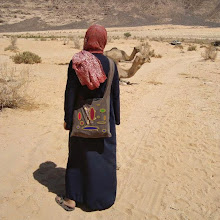At the beginning of November, I was waiting at the bus stop on my way to Aqaba when I was approached by Zidan, a friendly, talkative gentleman who works at Disi city hall.
"Lina," he said, "Dr. Edoardo is here. You must meet him!"
"Can you take me to him?," I replied.
"Yes," replied Zidan.
Dr. Edoardo - a Disi legend - is a Czech-German-Italian paleoanthropologist who has spent the past 40 years studying Wadi Rum and published over 300 articles - all in Italian - on his findings.
And so Zidan and I wandered down the main street of Disi to Dr. Edoardo's house on the far edge of the village. As we proceeded, Zidan took great pleasure in telling the people we met that he was taking me to Dr. Edoardo's house to marry him.
"No, no!," I protested, "I'm already married!" To no avail.
We arrived and were met by Dr. Edoardo and one of his colleagues. As it turned out, the only language that we shared was Italian and so I found myself translating from Arabic to English to Italian so that everyone could communicate. As I was in a bit of a rush to get to Aqaba, I agreed to meet the two scholars the following day for lunch.
I returned the next morning and spent a good part of the day (we had pasta for lunch!) learning about the research that Edoardo and his colleagues had done in the area. Dr. Edoardo's house, which is located on land given to him by Sheikh J'lael, the leader responsible for settling the Zawydeh tribe in Disi, is full of knowledge reflecting the history of the area. The walls of the house are covered with photographs, drawings and articles reflecting his work to date - including several representations of the rock inscriptions found throughout Wadi Rum. Most, if not all, of this rock art - inscriptions of figures and symbols in the sandstone - has been documented by Dr. Edoardo. I was fascinated to learn that the rock art in Wadi Rum can be anywhere from a few thousand years to a few decades old, as this art was the primary method of recording history used by the pastoral Bedouins until their settlement in the later part of the 20th century. My conversation with Dr. Edoardo opened my eyes to the speed and amount of change that has occurred in this part of Jordan over the past century.
Of course, I could not leave without a task to complete. As we looked through Dr. Edoardo's books, he informed that someone had inscribed the death of Lawrence (random motorcycle accident or calculated assassination attempt? you be the judge - the artist sure has!) in a cliff out in the desert. He described the place and I told him that I would go to look. And here, the next day, is what we found:
"Lina," he said, "Dr. Edoardo is here. You must meet him!"
"Can you take me to him?," I replied.
"Yes," replied Zidan.
Dr. Edoardo - a Disi legend - is a Czech-German-Italian paleoanthropologist who has spent the past 40 years studying Wadi Rum and published over 300 articles - all in Italian - on his findings.
And so Zidan and I wandered down the main street of Disi to Dr. Edoardo's house on the far edge of the village. As we proceeded, Zidan took great pleasure in telling the people we met that he was taking me to Dr. Edoardo's house to marry him.
"No, no!," I protested, "I'm already married!" To no avail.
We arrived and were met by Dr. Edoardo and one of his colleagues. As it turned out, the only language that we shared was Italian and so I found myself translating from Arabic to English to Italian so that everyone could communicate. As I was in a bit of a rush to get to Aqaba, I agreed to meet the two scholars the following day for lunch.
I returned the next morning and spent a good part of the day (we had pasta for lunch!) learning about the research that Edoardo and his colleagues had done in the area. Dr. Edoardo's house, which is located on land given to him by Sheikh J'lael, the leader responsible for settling the Zawydeh tribe in Disi, is full of knowledge reflecting the history of the area. The walls of the house are covered with photographs, drawings and articles reflecting his work to date - including several representations of the rock inscriptions found throughout Wadi Rum. Most, if not all, of this rock art - inscriptions of figures and symbols in the sandstone - has been documented by Dr. Edoardo. I was fascinated to learn that the rock art in Wadi Rum can be anywhere from a few thousand years to a few decades old, as this art was the primary method of recording history used by the pastoral Bedouins until their settlement in the later part of the 20th century. My conversation with Dr. Edoardo opened my eyes to the speed and amount of change that has occurred in this part of Jordan over the past century.
Of course, I could not leave without a task to complete. As we looked through Dr. Edoardo's books, he informed that someone had inscribed the death of Lawrence (random motorcycle accident or calculated assassination attempt? you be the judge - the artist sure has!) in a cliff out in the desert. He described the place and I told him that I would go to look. And here, the next day, is what we found:
 |
| Taking a Tumble? |
 |
| Vroom! Vroom! |
 |
| ?? |
 |
| The Whole Picture |

No comments:
Post a Comment